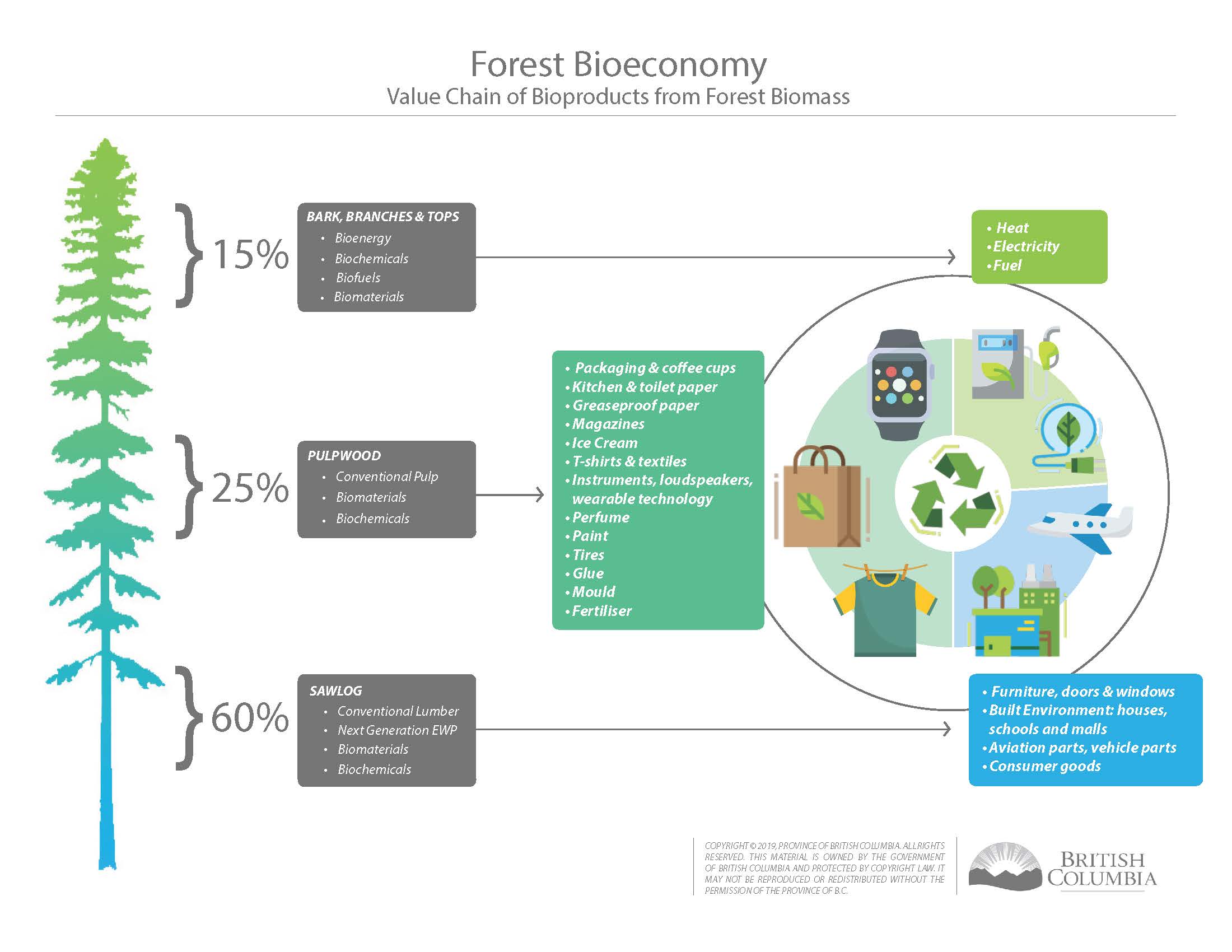Forest Bioeconomy in B.C.
The forest bioeconomy uses sustainably managed forest material, also known as forest biomass, to make bioproducts including consumer goods and industrial products. Forest biomass can be any forest material from trees to shrubs to branches to berries. A successful bioeconomy helps reduce petrochemical-based products in the economy.
On this page
- Purpose of the forest bioeconomy
- Why invest in B.C.'s forest bioeconomy?
- What are forest bioproducts?
- Partnering programs and initiatives
Purpose of the forest bioeconomy
The forest bioeconomy finds innovative uses for residual material from conventional forestry or non-timber forest products. In doing so, the forest bioeconomy shifts the forest sector to a high-value, waste-free circular economy that mitigates climate change.
The B.C. forest bioeconomy is still developing. It relies on partnerships with Indigenous peoples and private companies to create innovative, high-value bioproducts.
Why invest in B.C.'s forest bioeconomy?
By investing in the forest bioeconomy, B.C. encourages the diversification of the forest sector. Diversification offers new potential for:
- Creating good jobs
- Making room for an Indigenous-led approach to forestry
- Using residual fibre, formerly waste, as an untapped resource
This innovation aligns with the principles behind BC’s Zero Waste and Climate Change initiatives. The forest bioeconomy will help shift B.C. from a high-volume to a high-value forest sector as committed to in the Minister's Mandate.
What are forest bioproducts?
Forest bioproducts are commercial, industrial or consumer goods made wholly or substantially from forest biomass. B.C. has a mature and established forest sector mainly producing conventional forest products such as lumber, pulp, paper, veneers and furniture. The forest bioeconomy goes beyond these products and expands the sector by adding emerging bioproducts.
Click on the image below to enlarge the picture.
Bioproduct examples:
- Cellulose nanocrystals (PDF, 143KB)
- Pulp-reinforced thermoplastic composites (PDF, 137KB)
- Indigenous arts and crafts (PDF, 121KB)
- Bio-refining technologies – bio-char (PDF, 130KB)
- Bio-refining technologies – bio-coal (PDF, 124KB)
- Bio-refining technologies – bio-tar (PDF, 124KB)
- Wood residue composite (PDF, 114KB)
- Combined heat and power (PDF, 115KB)
- Essential oils extracted from commercial B.C. trees (PDF, 123KB)
- Western hemlock bark extract (PDF, 120KB)
- Wood fibre insulation (PDF, 119KB)
- Cross laminated timber (PDF, 136KB)
Partnering programs and initiatives
Supporting diverse products and innovative uses of our natural resources is an important part of diversifying our bio-economy. The province partners with multiple organizations, including:
- BC Bioenergy Network
- BC Community Climate Funding Guide for Indigenous Communities and Local Governments
- BCWood
- BioComposites Research Network (BioCRN)
- First Nation Clean Energy Business Fund
- Forestry Innovation Investment
- FPInnovations
- Indigenous Forestry Initiative
- Investments in Forest Industry Transformation
- Mass Timber Demonstration Program
- Pacific Economic Development Canada (PacifiCan)
- Woodworks BC
- Wood First Initiative
BC Community Climate Funding Guide
Administrative Fee Cap Policy
Contact information
IBIO.Mail@gov.bc.ca


